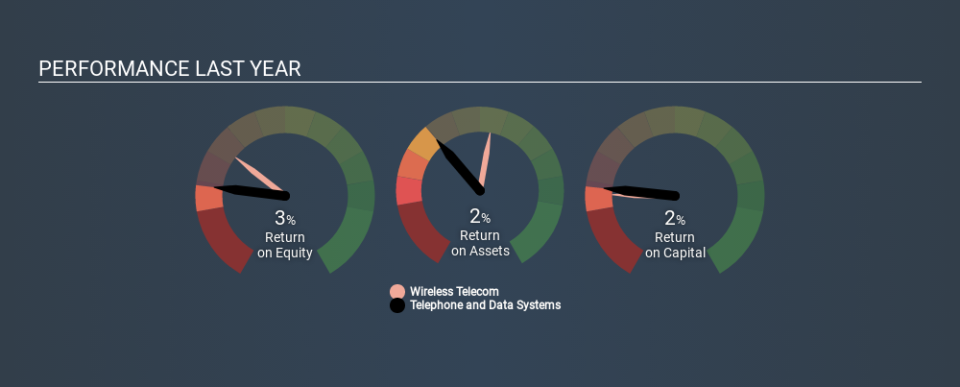Examining Telephone and Data Systems, Inc.’s (NYSE:TDS) Weak Return On Capital Employed

Today we are going to look at Telephone and Data Systems, Inc. (NYSE:TDS) to see whether it might be an attractive investment prospect. Specifically, we'll consider its Return On Capital Employed (ROCE), since that will give us an insight into how efficiently the business can generate profits from the capital it requires.
First of all, we'll work out how to calculate ROCE. Then we'll compare its ROCE to similar companies. Last but not least, we'll look at what impact its current liabilities have on its ROCE.
What is Return On Capital Employed (ROCE)?
ROCE measures the amount of pre-tax profits a company can generate from the capital employed in its business. In general, businesses with a higher ROCE are usually better quality. Overall, it is a valuable metric that has its flaws. Renowned investment researcher Michael Mauboussin has suggested that a high ROCE can indicate that 'one dollar invested in the company generates value of more than one dollar'.
So, How Do We Calculate ROCE?
The formula for calculating the return on capital employed is:
Return on Capital Employed = Earnings Before Interest and Tax (EBIT) ÷ (Total Assets - Current Liabilities)
Or for Telephone and Data Systems:
0.019 = US$190m ÷ (US$11b - US$962m) (Based on the trailing twelve months to December 2019.)
So, Telephone and Data Systems has an ROCE of 1.9%.
View our latest analysis for Telephone and Data Systems
Is Telephone and Data Systems's ROCE Good?
ROCE can be useful when making comparisons, such as between similar companies. We can see Telephone and Data Systems's ROCE is meaningfully below the Wireless Telecom industry average of 5.0%. This could be seen as a negative, as it suggests some competitors may be employing their capital more efficiently. Putting aside Telephone and Data Systems's performance relative to its industry, its ROCE in absolute terms is poor - considering the risk of owning stocks compared to government bonds. There are potentially more appealing investments elsewhere.
In our analysis, Telephone and Data Systems's ROCE appears to be 1.9%, compared to 3 years ago, when its ROCE was 1.3%. This makes us think the business might be improving. You can see in the image below how Telephone and Data Systems's ROCE compares to its industry. Click to see more on past growth.
When considering this metric, keep in mind that it is backwards looking, and not necessarily predictive. Companies in cyclical industries can be difficult to understand using ROCE, as returns typically look high during boom times, and low during busts. This is because ROCE only looks at one year, instead of considering returns across a whole cycle. Since the future is so important for investors, you should check out our free report on analyst forecasts for Telephone and Data Systems.
Telephone and Data Systems's Current Liabilities And Their Impact On Its ROCE
Current liabilities are short term bills and invoices that need to be paid in 12 months or less. Due to the way the ROCE equation works, having large bills due in the near term can make it look as though a company has less capital employed, and thus a higher ROCE than usual. To counteract this, we check if a company has high current liabilities, relative to its total assets.
Telephone and Data Systems has total assets of US$11b and current liabilities of US$962m. Therefore its current liabilities are equivalent to approximately 8.9% of its total assets. With barely any current liabilities, there is minimal impact on Telephone and Data Systems's admittedly low ROCE.
What We Can Learn From Telephone and Data Systems's ROCE
Nevertheless, there are potentially more attractive companies to invest in. But note: make sure you look for a great company, not just the first idea you come across. So take a peek at this free list of interesting companies with strong recent earnings growth (and a P/E ratio below 20).
If you like to buy stocks alongside management, then you might just love this free list of companies. (Hint: insiders have been buying them).
If you spot an error that warrants correction, please contact the editor at editorial-team@simplywallst.com. This article by Simply Wall St is general in nature. It does not constitute a recommendation to buy or sell any stock, and does not take account of your objectives, or your financial situation. Simply Wall St has no position in the stocks mentioned.
We aim to bring you long-term focused research analysis driven by fundamental data. Note that our analysis may not factor in the latest price-sensitive company announcements or qualitative material. Thank you for reading.

 Yahoo News
Yahoo News 

